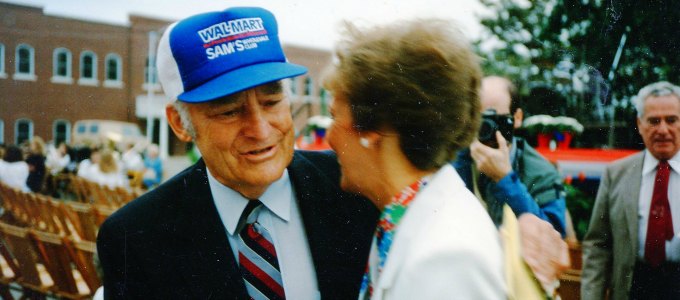Image courtesy of Flickr/Janice Waltzer
In November 1980, Sam Walton sent Wal-Mart employees a memo outlining “A Positive Approach to Managing People.” More than 34 years later, the new year seems like the perfect time to review and comment on Walton’s advice, which remains as valid as ever.
Walton reminded Wal-Mart employees that “all human beings want to be appreciated and respected, so managers should empathize with and motivate their people by appealing to their desire to improve themselves and be more productive.” He also pointed out that positive reinforcement will elicit extra effort “far beyond our reasonable expectations,” while managing by fear or demand will not produce long-term improvement.
An emphasis on positive reinforcement is a key component of behavioral analysis and underpins my company’s work in applying the principles of behavior in the workplace.
Here are the tenets that Sam Walton put forth in 1980 and my thoughts on them. You may want to add them to your 2015 resolutions.
1. Say a pleasant “good morning” to each associate, even though you may not feel pleasant yourself.
Set the tone, and adopt this practice because it’s good manners — it’s what your momma taught you to do. Pair yourself with positive interactions. Greeting employees cheerfully is an easy touch point.
While your “good morning” may lead to further conversation, which is great, most employees will view your mere acknowledgement as something you didn’t have to do — going out of your way.
When accompanied by a smile and occasionally stopping to chat about anything that may be of interest to the other person, your simple pleasantries are bound to improve relationships.
2. Remember associates’ first and last names, and always call them by one or the other.
Addressing people by their names is fundamental to building personal relationships where employees feel valued and motivated to do their best.
Roger Milliken, at one time owner of the largest privately held company in the U.S., knew the names of all managers and supervisors in Milliken & Co.’s more than 60 textile plants. He made it a priority. Each plant had pictures, positions and training for all management personnel. He reviewed each one twice a year.
After learning employees’ names, strengthen relationships by listening to employees’ ideas and opinions about almost anything. Do this with people at all levels of your organization. When I was a clinical psychologist, I found the most valuable part of a therapy hour was the time I spent listening. If you spend more time listening and less time telling, you will more likely to have a good relationship and set yourself apart in today’s rushed world, which puts a premium on talking. Listening and acting on what you hear is the foundation of a culture of engagement, and an engaged workforce will always work harder to be successful than one that is disengaged.
3. Learn something about hobbies, special interests, backgrounds and families of your associates. There is no stronger goodwill building than showing you care through personal interest.
As Walton says, finding out about and expressing interest in employees’ lives is another powerful way to make a relationship personal.
Personalizing interactions is a key element of positive reinforcement — the only behavioral consequence that can maximize all aspects of an organization’s performance. For guidance on how to practice positive reinforcement, including making it personal, I suggest reading Positive Reinforcement: Misunderstood and Misused.
4. Hand out a compliment now and then, even though there may be no particular reason to do so. As Mark Twain said, “Most of us can live on a good compliment for a month.”
Establish yourself as a reinforcer.Positive reinforcement is contagious. Go out of your way to reinforce good work. I can’t say this enough. It will make excellent performance grow exponentially.
For example, ask employees to tell you how they accomplished a particular task or result. Interrupt them in a positive way. By that, I mean productively engage them in a positive conversation. Employees will welcome your interjections if you’re known as someone who brings good news and has genuine interest in employees’ lives and achievements.
You’ll find more information on encouraging above-and-beyond behavior through positive reinforcement here.
5. Avoid the common habit of faultfinding to the exclusion of “good-findings.” Rate people by their successes instead of their faults. Take Babe Ruth. He held two world records: one for strikeouts (1,330) and one for home runs (714). You remember him for his successes. That’s the way we should remember our associates.
Benjamin Franklin offered these related pearls of wisdom: “Any fool can criticize, condemn and complain and most fools do,” and “Write people’s accomplishments in stone and their faults in the sand.”
We are trained to spot problems. There was a time when this ability was essential to survival. However, today, the imperative generally is creating satisfying and productive relationships at work and at home.
Keep the “4:1 Ratio” in mind. Research supports that the words managers use should include at least four positive comments for every one negative comment. That includes reinforcing behavior you want repeated, versus offering feedback on undesirable behavior.
In this vein, when behavior analyst Todd Risley paid teachers to find and recognize positive things students were doing, student behavior and achievement increased dramatically.
The same principle works in business. Most people do good, productive things considerably more often than negative, unproductive ones. Focusing on what employees do right is much more effective than waiting for them to do something wrong.
With these guidelines at the forefront, expect organizational success to climb in 2015. By success, I mean not only superior results but also a happier, more engaged and more productive workforce. The advice worked for Wal-Mart, and I’m sure it will help your organization.















